At Elevate, we know that identifying and securing grants is often the backbone of nonprofit funding strategies. We also realize that finding the right funders and crafting compelling proposals requires more than just a surface-level search—it demands strategic and comprehensive prospect research. Using multiple research tools is not just recommended; it’s essential for maximizing your grant success. Here’s why and how to do it effectively.
Why Use Multiple Prospect Research Tools?
Grantmakers often don’t reveal their full scope of funding interests on their websites. For example, a glance at the Susan Thompson Buffett Foundation’s website might lead you to believe they only offer scholarships to Nebraska students. However, digging deeper with tools like Candid’s Foundation Directory Online (FDO) or Inside Philanthropy reveals their significant contributions to reproductive health initiatives. This deeper understanding can help nonprofits determine strategic alignment and customize proposals accordingly.
Elevate’s Toolbox for Comprehensive Prospect Research
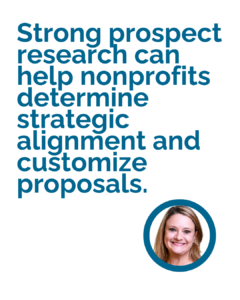 At Elevate, leveraging a mix of paid and free prospect research tools ensures high-quality outcomes for clients. Here’s a breakdown of some key tools and how they can elevate your grant-seeking efforts:
At Elevate, leveraging a mix of paid and free prospect research tools ensures high-quality outcomes for clients. Here’s a breakdown of some key tools and how they can elevate your grant-seeking efforts:
1. Salesforce (or your own donor database)
- What It Does: Tracks funder and opportunity records with comprehensive data, including email history and activity logs.
- Why It’s Unique: Elevate’s extensive internal database allows teams to analyze trends across thousands of funders. Collaboration is seamless, as team members can share insights and follow up on opportunities.
2. Candid (FDO)
- What It Does: Provides profiles on nearly 300,000 grantmakers and 2 million grant recipients, along with 990 forms, grant opportunities, and federal grant information.
- Why It’s Unique: Its LinkedIn integration and ability to export data to Excel make it a powerful tool for strategy analysis and networking.
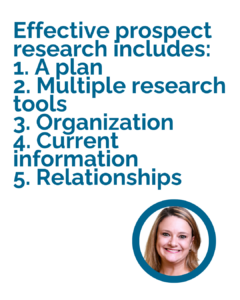 3. Inside Philanthropy
3. Inside Philanthropy
- What It Does: Features profiles of grantmaking organizations and tracks open RFPs with its GrantFinder tool.
- Why It’s Unique: Users can filter funders by issue, geography, and major donors while accessing articles on philanthropy trends.
4. Instrumentl
- What It Does: Generates comprehensive “funding landscapes” that highlight relevant funders and open opportunities in specific sectors.
- Why It’s Unique: Its “openness to new grantees” insights and high-volume prospect generation set it apart.
5. Free Tools (e.g., LinkedIn, CauseIQ, and Influence Watch)
- What They Do: Provide access to information on influencers, funders, and peer organizations. Tools like LinkedIn help build connections with program officers and grantmakers.
- Why They’re Valuable: Free resources often complement paid tools by filling in gaps or providing quick, high-level insights.
Best Practices for Effective Prospect Research
- Start with a Strategic Plan: Identify your funding priorities and narrow your search to tools and resources that align with your organization’s mission.
- Combine Tools for Deeper Insights: Cross-reference information from multiple sources to uncover hidden opportunities and verify funder alignment.
- Stay Organized: Log your findings, track communication history, and collaborate with your team.
- Stay Current: Regularly review platforms like Inside Philanthropy and the Chronicle of Philanthropy for updates on grantmaking trends.
- Engage with Funders: Use LinkedIn or email to connect with program officers, build relationships, and gain insight into funder priorities.
Conclusion
In today’s competitive funding landscape, successful grant seeking requires more than just a quick Google search. By utilizing multiple prospect research tools, nonprofits can uncover opportunities that align with their mission, craft tailored proposals, and build lasting relationships with funders. With a well-rounded approach to research, your organization can maximize its chances of securing the grants it needs to thrive.
And for more on prospecting, join us for Elevate’s popular Prospect Research: How to Find Grant Opportunities webinar.
As my colleagues have explored in previous blog posts, including this article on how to write a persuasive need statement, using accurate data in your proposals is a cornerstone of successful grant writing. However, not all data is the same. One critical yet often overlooked area is grant program data—the information related to donor details, application deadlines, submission tracking, and funding history. Managing this data effectively ensures nonprofits can strengthen relationships with grantmakers, prioritize their focus, improve their application strategy, and secure more funding.
Despite its importance, many nonprofits struggle to track and utilize grant program data efficiently. As a Project Coordinator at Elevate, I work every day to ensure my clients have clear, accurate data to support decision-making and ensure their grant programs run smoothly. In this blog, I will explore why it matters and provide actionable tips from my experience with several organizations to help nonprofits improve their grant data management.
Why Grant Program Data Matters in Grant Writing
Strengthening Relationships with Grantmakers
When grantmakers can see that their grantees are organized and strategic in their interactions, it engenders trust and confidence in the nonprofit. Tracking key details such as past funding amounts, reporting deadlines, and communication history – and using these data points to make decisions about how to approach a grantmaker – helps organizations tailor proposals and maintain strong relationships.
For example, some funders won’t allow you to submit a proposal for a renewal grant without submitting a final report, and often that reporting information can be found in the weeds of a grant agreement. When this type of information is tracked properly it helps to avoid missed opportunities for financial support.
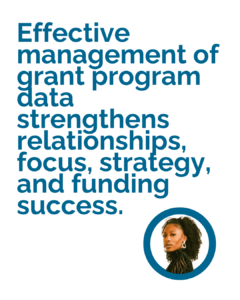 For example, one Elevate client had gaps in their grant calendar where they should have had grant report deadlines. We discovered this was due to missing and poorly tracked grant agreements – where the information about reporting requirements could be found! This information gap led to several missed report deadlines, putting our client’s funder relationships at risk and delaying new funding (because reporting was required before grants could be renewed.) Once we discovered the source of the missing information, we were able to compile and organize grant agreements and pull reporting deadlines and requirements from those documents to fill those crucial gaps in the calendar.
For example, one Elevate client had gaps in their grant calendar where they should have had grant report deadlines. We discovered this was due to missing and poorly tracked grant agreements – where the information about reporting requirements could be found! This information gap led to several missed report deadlines, putting our client’s funder relationships at risk and delaying new funding (because reporting was required before grants could be renewed.) Once we discovered the source of the missing information, we were able to compile and organize grant agreements and pull reporting deadlines and requirements from those documents to fill those crucial gaps in the calendar.
Beyond maintaining relationships, tracking interactions with grantmakers allows nonprofits to personalize their approach. By logging notes from conversations with program officers, feedback on proposals, and preferences about how and when requests are made, organizations can refine their applications to align with a funder’s priorities.
Another nonprofit that Elevate worked with was fortunate to work with a gracious program officer who was willing to provide feedback on our application in advance of our submitting it. By addressing this feedback in our application, we significantly strengthened our chances of securing funding. And, because the grantmaker was aware of our client’s intent to submit a request, the application was expected which further increases the likelihood of grant allocation.
Improving Application Success Rates
Nonprofits that manage their grant program data effectively can refine their application strategies. By analyzing data on past submissions, organizations can identify patterns—such as which types of requests are most successful (e.g. program restricted requests vs. general operating requests) or which types of grantmakers tend to fund similar projects.
Another key benefit is the ability to analyze rejection trends. If an organization sees a pattern of rejections from a specific type of funder, they can reevaluate how to frame their applications or shift focus to better-aligned funding sources. Proactively assessing past grant performance enables smarter, more targeted outreach. (Also check out this blog post for what to do when a grant is declined!)
For example, one Elevate client applied for a grant several times and was not awarded funding. They decided to shift their efforts instead to new funding opportunities and won a grant from an organization they had not previously partnered with. This was a great way to utilize data on the organization’s history with a grantmaker (i.e. multiple rejections) to determine whether an opportunity is worth pursuing again in the future.
Avoiding Missed Deadlines and Compliance Issues
Deadlines and reporting requirements vary across grantmakers. Missing a deadline—or failing to submit required reports—can jeopardize future funding opportunities. Beyond deadlines, tracking compliance requirements, such as submitting receipts or financial statements, ensures that nonprofits meet all necessary reporting expectations. Some funders require extensive narrative progress reports, while others focus on financial accountability. Having a centralized data system helps organizations quickly retrieve the necessary documents when requested, reducing stress and improving efficiency.
Common Challenges in Grant Data Management
Disorganized or Incomplete Records
Many nonprofits store grant information in multiple locations—spreadsheets, emails, or even paper files—leading to gaps and inconsistencies. This is especially true when a team member who is holding critical information leaves the organization or needs to be away unexpectedly. A centralized system ensures all relevant details are easily accessible and up to date.
Some organizations struggle with inconsistency in data entry, with different team members tracking information in different formats. Establishing a standardized method can ensure data remains accurate and easy to interpret. This can be as simple as having standard naming conventions for documents or folders organized by year and grantmaker. Consistency is key!
Loss of Institutional Knowledge
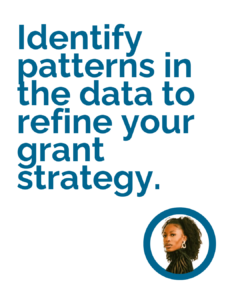 Staff turnover can lead to the loss of critical grant program data. Without a structured system, new team members may struggle to pick up where others left off. Establishing clear documentation, standards, and processes mitigates this risk and allows for smoother transitions between teams.
Staff turnover can lead to the loss of critical grant program data. Without a structured system, new team members may struggle to pick up where others left off. Establishing clear documentation, standards, and processes mitigates this risk and allows for smoother transitions between teams.
An Overwhelming Volume of Data
Some organizations collect excessive information without a clear strategy for its use. Prioritizing key data points such as funding cycles, grant amounts, feedback notes, and reporting requirements—prevents information overload.
Nonprofits should also focus on actionable data that directly impacts their ability to secure funding. Instead of tracking every minor interaction, prioritizing key engagement milestones, funding patterns, and funder preferences ensures the most relevant insights are easily accessible. Adding dates to these interactions and the point of contact can help track the lifespan of these organizational interactions.
Best Practices for Managing Grant Program Data
Standardize Data Entry and Tracking
Establish a uniform system for logging grant-related information. Consider using a grant management platform like Salesforce or Notions to centralize tracking. Clients working with Elevate have a detailed and organized grants calendar with historical information for the duration of our partnership. This grant calendar is consistently updated with relevant information.
A grant tracking system should include for each grantmaker:
- LOI and proposal deadlines
- Grant submission requirements (application points, required documents)
- Grant submission history (dates, amounts, outcomes)
- Reviewer feedback
- Reporting deadlines
- Key interactions and communications with program officers
- Renewal opportunities (i.e. plans for future funding requests)
For more tips, check out this Elevate blog post on How to Manage a Grant Calendar.
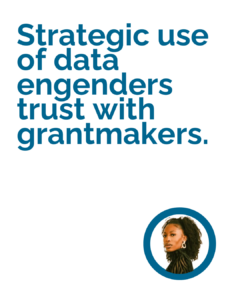 Set Up Automated Reminders
Set Up Automated Reminders
Missing a proposal deadline can mean missing out on funding, whereas missing a reporting deadline can jeopardize your relationship with a grantmaker. Automated calendar reminders for upcoming deadlines, progress reports, and renewal opportunities keep nonprofits on track.
Train Your Team on Data Best Practices
A well-trained team ensures consistency in grant tracking. Regular training on data management best practices helps organizations avoid common pitfalls. Elevate has helped clients implement grant tracking that drastically improved internal coordination and grant success rates through our trained staff.
Regular training can also help organizations adapt to changes in funder expectations. By staying informed on best practices, teams can adjust strategies in real time to improve their success rates.
Conclusion
Accurate and well-managed grant program data is essential for securing funding and building strong relationships with grantmakers. By implementing structured tracking systems, nonprofits can increase efficiency, improve proposal success rates, and maintain compliance with funding partners’ requirements.
For many nonprofits, federal grants and contracts are just one part of their larger revenue profile. With the news to date this year dominated by updates regarding reductions in federal funding, little advice is available about how policy change at the federal level contributes to changes in private funding priorities and availability.
In early 2025 Elevate hosted a three-part Conversation Series on Navigating Uncertainty in the Funding Landscape. The first of these – But what about private grants? – covered our responses to 5 questions Elevate’s nonprofit partners have asked about their private foundation grant strategy in the context of uncertainty around federal funds.
This article provides highlights from the Conversation Series session, including the questions, key considerations, and Elevate’s advice for nonprofit leaders.
Question #1: If we lose public funding for our programs, can we replace it with increased support from foundations or corporations?
If your federal grants or contracts are rescinded or ended, it is unlikely that you will be able to replace that funding with private support.
 First, there is far more public funding than private funding. In 2023, the federal government provided $303 billion in grants and contracts to nonprofits, whereas private foundations award around $107 billion annually to U.S. nonprofits. It is not reasonable to expect that private philanthropy could “step up” and fill this gap.
First, there is far more public funding than private funding. In 2023, the federal government provided $303 billion in grants and contracts to nonprofits, whereas private foundations award around $107 billion annually to U.S. nonprofits. It is not reasonable to expect that private philanthropy could “step up” and fill this gap.
Instead, private philanthropy is likely to get more competitive in a period of constrained resources. We expect that more organizations will be appealing to foundations for limited private funds, and that grantmakers may opt to focus their own limited resources on supporting those organizations with whom they already have relationships.
Second, private funders are unlikely to prioritize filling the gap created by a loss of public funding. Philanthropy sees their role as distinct from the public sector. Private grantmakers are more likely to be interested in opportunities to build capacity, test new ideas, and establish the evidence for what works, whereas public funding is often leveraged to support direct programmatic services. What’s more, private funders who want to demonstrate resistance to the current administration do not want to step into this gap because it takes the pressure off of the government to play their part.
At the end of the day, there is simply no equivalency between public and private funding and one cannot build effective fundraising strategies that assume private funders will simply “step up” where public funding is declining.
Question #2: What can I do today to shore up my existing private funding streams?
We all care a lot about the work we do and the communities we work with, so it can be hard to discuss the possibility that we will have to navigate a period of fewer resources and less support for the communities we serve. So, what can nonprofit leaders do now?
 First, talk with your funding partners. Foundations and corporations rely on their grantees to tell them about community needs – it’s why nearly every grant proposal requires you to define the need you are addressing. When things are changing quickly, as they are now, grantmakers have less insight than you do about whether the need is increasing, decreasing, or just changing. Be proactive – don’t wait for your funders to ask. Reach out to make them aware of what’s happening at your organization and offer to be a resource to funders who want to be part of the conversation.
First, talk with your funding partners. Foundations and corporations rely on their grantees to tell them about community needs – it’s why nearly every grant proposal requires you to define the need you are addressing. When things are changing quickly, as they are now, grantmakers have less insight than you do about whether the need is increasing, decreasing, or just changing. Be proactive – don’t wait for your funders to ask. Reach out to make them aware of what’s happening at your organization and offer to be a resource to funders who want to be part of the conversation.
As we saw during COVID-19, the foundations and corporations who already know and trust your work are those you can go to first and most easily when the community needs are changing. Because you have already made the case to them, they already know the needs your organization addresses, and you can focus on updating them on how things are changing in the current context.
Similarly, when the future is highly uncertain, it is harder for philanthropists to invest in new grantees. Many grantmakers will opt to increase funding for their current grantees who are reaching out with requests for additional support. Others may not have the capacity to get to know new organizations and the needs they address while the foundation itself is reworking its own priorities in a period of change. Developing a new funding relationship is never easy, and it will likely be even more challenging in the current context.
Question #3: How do I talk to my funding partners about all of this?
Your donors are going to be hearing from all of their grantees – plus organizations seeking new support – during this time of uncertainty. The calls for additional support will be coming from all sides, and you’ll have to work even harder now to stand out from the crowd.
 Keep in mind that the best practices of cultivation and stewardship still apply: keep in touch with your donors, update them about your work, and offer to be a resource to them about what is happening on the ground.
Keep in mind that the best practices of cultivation and stewardship still apply: keep in touch with your donors, update them about your work, and offer to be a resource to them about what is happening on the ground.
Start by asking questions. What are foundation leaders thinking about and grappling with themselves at this time? How can you – as a community leader – help them understand the impact of the Executive Orders and other federal actions on your organization and your community? Use what you know about the funder’s history of giving, the concerns they share, and the relationship you’ve built to be explicit about how you are aligned.
Be specific about the ways your organization is being impacted. Have you lost important sources of funding? Are you concerned about possible legal actions? Are the people you serve at risk of losing rights or services? How can private funding make a real difference for the community you serve or for whom you advocate in this context?
Finally, while making the case for the need for funding, what positive news can you share about how your organization has prepared to navigate the weeks, months, and years ahead that will give your funders a sense that continued (or increased!) funding is a good investment? What leadership expertise, financial strategies, or planning do you have in place to support your organization’s ability to navigate difficult circumstances? In other words, make your request from a position of strength, rather than from a position of distress or alarm.
Question #4: Should we change how we talk about our DEI work?
The backlash against Diversity, Equity, and Inclusion efforts makes many feel unsafe, while others may feel disheartened by the clash between the discourse and their own values.
 The efforts to dismantle DEI in philanthropic and nonprofit sectors predates the recent Executive Orders. Our colleague, Johnisha Levi, published an informative and well-researched article last year highlighting the impact of the June 2023 Supreme Court decision, which found that Harvard’s “race conscious” admissions violated the Constitution. This was the beginning of a significant sea change against affirmative action and other DEI strategies that is now being amplified by the current administration.
The efforts to dismantle DEI in philanthropic and nonprofit sectors predates the recent Executive Orders. Our colleague, Johnisha Levi, published an informative and well-researched article last year highlighting the impact of the June 2023 Supreme Court decision, which found that Harvard’s “race conscious” admissions violated the Constitution. This was the beginning of a significant sea change against affirmative action and other DEI strategies that is now being amplified by the current administration.
While the anti-DEI Executive Orders are challenged in court, public and private institutions find themselves in limbo.
If you receive direct federal funding, you have likely already received instructions from the granting agency on what will need to change about how you talk about your work or about the work you actually do with your grant funds. If you receive pass-through funding, the guidance may come later as the information trickles down to sub-grantees.
While they receive these notices about their federal grants, many of our clients have asked whether they should be taking similar steps to change the language around DEI in their private grant applications.
We caution against making dramatic changes to how you talk about your work until you know more about each foundation or corporate funder’s stance. There will likely be some grantmakers that will increase their support of organizations working with immigrants, supporting the LGBTQIA+ community, or advancing race equity in their communities. Others may take a more conservative approach.
At this time, most private and corporate funders have not had a chance to change their application templates, so they will continue to ask for demographic information about the community you serve, your staff and board, and other details. You should still fill that information out as accurately as possible.
Question #5: How do I plan for the future?
The past 5 years have been a historically hard time to lead a nonprofit, and a key reason for that is the pressure that comes from knowing that people rely on the work you do to meet their basic needs, learn and grow, maintain or improve their health, access employment and opportunities that benefit their families, and more.
 Considering a future where you have fewer resources and are thus less able to do this important work can be overwhelming.
Considering a future where you have fewer resources and are thus less able to do this important work can be overwhelming.
At this point, our advice is to:
- Focus on What Matters Most: What is your unique and essential contribution to your community? This is what you prioritize over everything else.
- Phone a Friend (or Many Friends): Call that extra board meeting. Gather information from your community advisory board. Talk to your staff, beneficiaries, and partners to understand what they need, what they can offer, and how you can work together.
- Plan for Multiple Futures: Where is your funding coming from? What does your financial picture look like if one funding stream disappears? What does it look like if some but not all of your private/corporate funding continues?
Explore other resources and insights from the Navigating Uncertainty series:
New year, new grant services–that’s the saying right? Either way, I am very excited for the opportunity to share more information about the launch of Elevate’s newest services: the Grants Accelerator Project Suite. These projects are designed to take the strategic grant work that Elevate is known for and package it into bite size pieces that are perfect for organizations that are just getting their grant programs started. Read on to learn more about Elevate’s new offerings and how you can move forward if they sound right for you.
If you’ve been in Elevate’s orbit for a while, this name may sound familiar–for the last several years we have offered a three- or four-month Grants Accelerator Project that brought together grants strategy guidance, prospecting, and language generation. We’ve worked with dozens of organizations on these projects, helping to stand up new grant programs and set organizations on the path to grant sustainability. However, we recognized that this package wasn’t quite right for organizations that were really trying to figure out how to get started from square one, and that the bundling of multiple types of support could lead us to inadvertently miss the mark on what an organization really needed. So, in 2024 we decided to deconstruct the Grants Accelerator Project into its component parts (and add a few new projects!) to create the Grants Accelerator Project Suite!
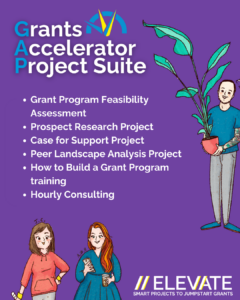 Through the new GAP Suite, we’re excited to offer a menu of project-based engagements that are cost efficient, maintain a laser focus on a specific component of an effective grants program, and are modular in order to build on each other in the way that makes the most sense for each organization. Each project within the GAP Suite is a four- or six-week collaboration designed to address a specific strategic fundraising need or question. While we have a standard sequence that many organizations will fit into, we can build out a series of engagements that best fits your needs and resources on a timeline that works for you.
Through the new GAP Suite, we’re excited to offer a menu of project-based engagements that are cost efficient, maintain a laser focus on a specific component of an effective grants program, and are modular in order to build on each other in the way that makes the most sense for each organization. Each project within the GAP Suite is a four- or six-week collaboration designed to address a specific strategic fundraising need or question. While we have a standard sequence that many organizations will fit into, we can build out a series of engagements that best fits your needs and resources on a timeline that works for you.
We’ve built these projects for small organizations that are at the beginning of their grant journey as well as for those that are interested in launching a new initiative or program that would require new dedicated grant funding. They are perfect if you are looking for guidance on how to get started with grants or need to figure out how to convert your initial seed funds into a more sustainable pipeline. Because we know that it can be difficult to commit to a long-term engagement, these projects are intentionally short and highly focused. At the end of each project, we’ll discuss what your next steps could look like within the GAP suite or within your organization.
If you’re interested in learning more about these new options, check out the GAP Suite page on Elevate’s website. On that page, you’ll find more information about each of the different projects and instructions on how to get started. You’ll also find information on how to join an upcoming GAP info session where you can ask questions before you get started. We look forward to seeing you there!
Friends and partners of Elevate, it’s time for an annual tradition – our look back at the previous year by-the-numbers!
Last year brought change and uncertainty throughout the nonprofit sector – from the continued proliferation of AI tools and billionaire philanthropists making transformative grants through open calls, to a turbulent presidential election, an overall decline in nonprofit revenues, and specific risks to programs that support marginalized groups.
Here at Elevate, 2024 was indeed a milestone year. Here are a few of the key data points that shaped our year.
We raised our one billionth dollar and hit the 100+ million mark for the 4th year running
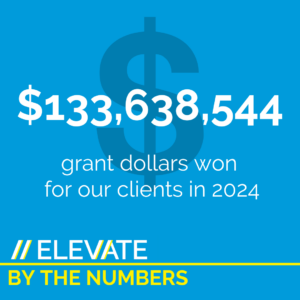 The headline this year is of course the grant dollars we secured to support our nonprofit partners. This summer, we hit a major milestone: raising $1 billion in grant funding since Elevate’s founding in 2013. In a press release, Elevate’s Founder and CEO, Alayna Buckner said, “This achievement is a testament to the hard work, skill, and dedication of our staff. But at the end of the day, this milestone belongs to the nonprofits we serve and the work they are doing in their communities.”
The headline this year is of course the grant dollars we secured to support our nonprofit partners. This summer, we hit a major milestone: raising $1 billion in grant funding since Elevate’s founding in 2013. In a press release, Elevate’s Founder and CEO, Alayna Buckner said, “This achievement is a testament to the hard work, skill, and dedication of our staff. But at the end of the day, this milestone belongs to the nonprofits we serve and the work they are doing in their communities.”
Of course, we didn’t stop there! In 2024, Elevate’s clients secured $133,638,544 in grant funding with our support. This is not only the highest annual total in Elevate’s history, but it also marks the 4th consecutive year we’ve raised over $100 million in total. That’s a lot of funding going to support housing, health services, education, grassroots organizing, policy advocacy, climate change mitigation, reproductive justice, and much more. To hit that high mark, we submitted 3,148 total deliverables (LOIs, proposals, and grant reports) last year.
The average and median grant award is (slightly) up; the overall win rate is (slightly) down
Digging into the total dollars raised a bit further, the average grant awarded to Elevate clients in 2024 was an impressive $147,703, and the median award was $30,550. This is up somewhat from last year’s average grant award of $131,172 and median of $30,000.
At the same time, our average win rate – that is, the percentage of grants that were ultimately awarded – is slightly down in 2024, following a recent trend. Elevate’s win rate in 2024 was 49%, as compared with 56% in 2023 and 65% in 2022. Prior to 2022, Elevate’s win rate remained steadily in the 50% range for several years. What remains true is that this is well above the national average win rate of 18%.
As we continue to track data and make sense of the past four years in our sector, our CEO Alayna Buckner hypothesizes that perhaps Elevate’s outlier win rates in 2022 specifically reflects the impact of excess dollars flooding into the sector due to COVID along with relaxed philanthropic expectations at that time. If this is true, it would mirror other changes that Elevate and our clients are seeing, where philanthropy adapted in 2021 and 2022 to the global pandemic, but began to return to previous trends starting in late 2023 and all of 2024.
Hundreds of organizations across the sector trust Elevate to support their grants programs
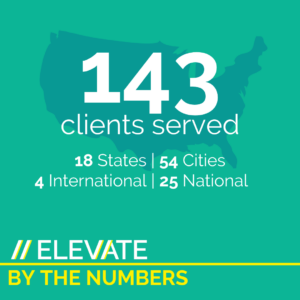 In total, Elevate partnered with 143 nonprofit organizations in 2024, including 110 nonprofits that engaged us for our signature Comprehensive Grant Writing Services with an average client tenure of over 4 years.
In total, Elevate partnered with 143 nonprofit organizations in 2024, including 110 nonprofits that engaged us for our signature Comprehensive Grant Writing Services with an average client tenure of over 4 years.
Our partners include nonprofits large and small, working across the country in a wide range of issue areas. Among those organizations we worked with last year, 4 serve an international audience and 25 have a national reach. Our clients are headquartered in 54 cities across 18 states, and the top 3 cities where Elevate clients are headquartered include Washington, D.C., Los Angeles, and New York.
Elevate partner organizations have annual budgets ranging from $400,000 to $1.8 billion, with a median annual budget of $5 million. And the top 3 issue areas in which Elevate clients work are:
- Health, Human Services, and Housing
- Education and Training
- Advocacy, Policy, and Organizing
None of this is possible without our talented staff!
Of course, none of the major successes outlined here would be possible without Elevate’s talented team of grant professionals. Elevate employs 67 individuals who work remotely from 26 states across the U.S. This includes 15 staff in the Director or Senior Director role, 20 Grant Writers and Grant Specialists, and 8 Project Coordinators, as well as a team of managers and support staff who work behind the scenes to keep things running smoothly.
Elevate invests in staff development and wellbeing. Last year, staff took advantage of their annual professional development fund to the tune of $15,295 invested in learning and professional growth. And 5 staff took advantage of a 4-week paid sabbatical, a benefit offered to tenured staff to support opportunities for travel, personal growth, reflection, and more.
As we enter 2025, we’re both cautious and optimistic about what is to come. While change and uncertainty will undoubtedly continue, we remain true to our founding values. Specifically, at Elevate we believe that progress is possible, and nonprofits make the world better.
Click here to access our 2024 Elevate By the Numbers infographic, and review our 2023 By the Numbers and 2022 By the Numbers blog posts.
If you’re interested in exploring whether Elevate is the right partner to support your organization’s grant program in 2025, we’d love to hear from you!
Welcome back to our two-part blog series on Ethical Storytelling, which kicked off last fall with a blog providing an introduction to the topic. Whereas that article provided some background and definitions (the “what” and the “why”), this one delves more into the “how” of ethical storytelling by providing examples from two Elevate partners.
Storytelling is crucial to any work to dismantle systemic barriers to opportunity. Research shows that people transported into narratives are more likely to adopt beliefs, attitudes, and behaviors implied by a story. For nonprofits that work with children, families, and communities that have experienced systemic oppression, it can be hard to find the right balance when crafting stories that focus on the barriers caused by those systems, such as poverty, educational inequities, homelessness, and food insecurity. It’s important for nonprofit organizations to have an intentional approach to gathering information to tell their clients’ stories and invest in their staff’s storytelling capacity.
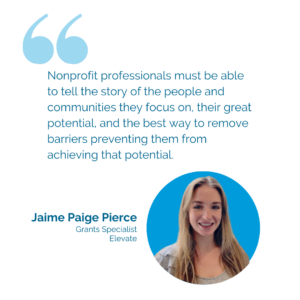 More specifically, nonprofits must use stories to create emotional connections while also highlighting the root causes of the disparities their clients face. It’s especially important when telling stories of communities that face oppression with funders, decision-makers, and other stakeholders who might not have had the same lived experience as the nonprofit’s clients. If done well, storytelling will counter stereotypes and biases that exist in society and avoid exploiting the clients’ experiences. It will also avoid relying on harmful narratives that inadvertently prevent progress within the communities the nonprofit exists to serve. If nonprofits are to fulfill their job to improve society, they must center equity in everything they do, including the language and stories they use.
More specifically, nonprofits must use stories to create emotional connections while also highlighting the root causes of the disparities their clients face. It’s especially important when telling stories of communities that face oppression with funders, decision-makers, and other stakeholders who might not have had the same lived experience as the nonprofit’s clients. If done well, storytelling will counter stereotypes and biases that exist in society and avoid exploiting the clients’ experiences. It will also avoid relying on harmful narratives that inadvertently prevent progress within the communities the nonprofit exists to serve. If nonprofits are to fulfill their job to improve society, they must center equity in everything they do, including the language and stories they use.
Nonprofits regularly communicate their purpose and vision to funders, decision-makers, advocates, and other stakeholders to attract the support they need to accomplish their goals. They must be able to tell the story of the people and communities they focus on (the need), their great potential (the vision), and the best way to remove barriers preventing them from achieving that potential (the activities/strategies) and positive outcomes. One way nonprofits are beginning to make this shift is by adopting ethical or trauma-informed storytelling.
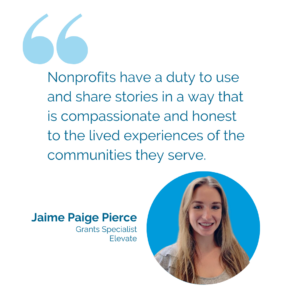 When setting out to learn from individuals’ lived experiences, nonprofit professionals must approach this in a way that recognizes the impact of gathering stories from those who have experienced systemic barriers to opportunities and trauma. Focusing on clients’ potential instead of the hardship they have endured can be empowering and provides an opportunity for them to help others who are experiencing similar challenges. By sharing their full humanity, they can change people’s perspectives for the better. Nonprofits that successfully leverage ethical or trauma-informed storytelling can communicate their purpose by sharing impactful stories from their clients’ perspectives while helping new audiences better understand the issues they work on.
When setting out to learn from individuals’ lived experiences, nonprofit professionals must approach this in a way that recognizes the impact of gathering stories from those who have experienced systemic barriers to opportunities and trauma. Focusing on clients’ potential instead of the hardship they have endured can be empowering and provides an opportunity for them to help others who are experiencing similar challenges. By sharing their full humanity, they can change people’s perspectives for the better. Nonprofits that successfully leverage ethical or trauma-informed storytelling can communicate their purpose by sharing impactful stories from their clients’ perspectives while helping new audiences better understand the issues they work on.
Importantly, nonprofits have a duty to use and share stories in a way that is compassionate and honest to the lived experiences of the communities they work with. How can nonprofits make sure they are fulfilling this duty? Two Elevate clients have generously provided some information about the strategies they use to best share the change they seek.
Children’s Law Center
In collaboration with DC children, families, community partners, and pro bono attorneys, Children’s Law Center (CLC) DC uses the law to solve children’s urgent problems today and improve the systems that will affect their lives tomorrow. Their vision is a world where every child has a stable family, good health, a quality education, and one in which racism, trauma, and poverty are eliminated as barriers to success.
To shape ethical and empowering storytelling, attorneys and social workers on staff work collaboratively with the communications team to connect families who are interested in sharing their stories. Taking what has been learned from doing this work for years, CLC now uses a detailed consent process. The children and families that CLC interviews have full authority to decide what can be shared from their experience, where it can be shared (i.e., online, print, social media), and what it can be used for (i.e., fundraising, policy advocacy, general outreach, etc.).
In crafting the stories of children and families with consent, the organization aims to share more than just the specific time period when CLC worked with the family or child. Stories include details on how a family advocated for changes before they began working with CLC, how a child is doing multiple years after working together, or fun personal details about the child’s interests to make it more than just the challenge or problem at hand.
Education Law Center
Education Law Center (ELC)-PA ensures access to a quality public education for all children in Pennsylvania. ELC-PA is a known resource for parents, child-serving professionals, and advocates in Pennsylvania to call, providing right-based information and advice regarding public education matters. ELC-PA is also a leader in public education advocacy for the legal and policy changes they have helped secure, focusing on equal access to quality public education, fair school funding, and dismantling the school-to-prison pipeline.
Alongside staff, organizational leadership continuously assesses ELC-PA’s language (in job descriptions, resources, newsletters, organizational policies, and more) to ensure it is inclusive and affirming to all clients and staff. To help staff make decisions about the language they use, ELC-PA’s Communications team created a tool to help them shape strengths-based messaging.
The ELC-PA Messaging Checklist asks:
- Have the systems and disproportionalities been highlighted and explained (name the root causes), or is the reader asked to fill in gaps with preexisting assumptions?
- Is my language blaming the student/caregiver for the unjust circumstance?
- Is the language I used how I want my loved ones to be described?
Trauma-Informed Storytelling
Some nonprofits have expanded ethical storytelling, which focuses more on consent processes and how stories are written, to include a focus on trauma-informed storytelling. This practice sets clearer boundaries, such as: 1) ensuring nonprofits aren’t interviewing children or families who are currently in crisis, 2) waiting until the work with the client is over (e.g., a legal case is closed), and 3) having social workers or other support staff be available for the interviewee. Sometimes, the act of sharing a story can reopen painful and traumatic memories, making this step important depending on the nonprofit’s focus area. To dive further into ethical and trauma-informed storytelling, check out the three-part webinar series by the Pro Bono Institute.
We hope this helps you further prioritize sharing the full humanity of the people and communities your work focuses on. For more information on the Children’s Law Center’s ethical storytelling process, including sample consent forms, go here. For information on ELC-PA, go here.
Cultivating and stewarding grantmakers are important steps in the grants cycle, as this is your chance to develop relationships and lasting partnerships that can sustain your organization in the long-term. However, it can be easy to fall prey to missteps and missed opportunities as you perform outreach. This article outlines a few of the most common errors we see nonprofits make in the process.
But first, a few definitions:
- Cultivation is the process of establishing a relationship with a prospective funding partner, often with the aim of securing an invitation to apply for funding or support advocating for your organization in the proposal review stage.
- Stewardship is the process of maintaining and growing a relationship with a funding partner over time, with the aim of securing renewal grants or opportunities for long-term funding for the organization.
Without further ado, here are 5 common mistakes we see organizations make – and advise our partners to avoid! – during this crucial step of the grant cycle.
1) Not cultivating funders at all
 Grant writing can be a time-consuming activity, so it’s tempting to skip the step of reaching out to a prospective funder before clicking “submit”. While you can often submit a “cold” proposal and still see success, there are a myriad of benefits for engaging in cultivation.
Grant writing can be a time-consuming activity, so it’s tempting to skip the step of reaching out to a prospective funder before clicking “submit”. While you can often submit a “cold” proposal and still see success, there are a myriad of benefits for engaging in cultivation.
For example, I’ve had many experiences where a program officer was able to answer questions and advocate on behalf of a proposal to a foundation’s decisionmakers, such as trustees, because I had had one or more conversations with them prior to submission.
Additionally, by speaking with program officers, you may get nuanced insight into what funders are interested in supporting, appropriate ask amounts, and more. You might even learn that they’re not the right funding partner for your organization, thereby saving you time and effort putting together a proposal that is not going to result in funding.
While it is difficult to quantify the impact of cultivation, there is no question that opportunities that are cultivated have a higher likelihood of success.
Finally, it’s important to note that cultivation is essential in order to pursue foundations that only accept proposals from organizations they’ve invited to apply.
2) Cultivating the wrong person
We’re big fans of research at Elevate for many reasons, but when it comes to cultivation, doing the proper research ahead of time can spare you a wild goose chase. Depending on the size and structure of the foundation, who you cultivate will look different.
For example, you might start by reaching out to:
- Program Officers and other staff or consultants;
- Board Members or Trustees; or
- Thought leaders and others in the field who know the grantmakers and can champion your work. For example, if you work for an affordable housing organization and are part of community coalitions, is there a local leader that can leverage their relationship with a funder and facilitate a connection?
In order to determine the right place to start, consider:
- The makeup of the foundation’s staff – if they have program officers for specific issue areas, these are probably the individuals you need to get to know!
- The type of foundation – small family foundations may make decisions at the behest of Trustees, so you’ll need to start there.
- The foundation’s influence in the field – if cultivating a major player in your field that everyone wants a meeting with, you may be best served by identifying someone who can make a “warm” introduction.
By doing your due diligence, you have a better chance of identifying the right person for outreach, thereby increasing the impact of your cultivation activities.
3) Giving up too soon
Reaching out to a funder can make one feel vulnerable, so you may hope to do it once and see results. Unfortunately, if you don’t have a warm connection that can introduce you to the right point of contact at a foundation, it’s likely going to take several tries to get a response.
Elevate typically recommends making at least 3 attempts at outreach before you pause outreach to a prospective grantmaker and move on. Remember: no response is not necessarily a no forever. You can always circle back to a no-response funder periodically after your initial attempts, especially if you have updates to share. Be persistent!
4) Not having a plan for your first conversation
While a cultivation conversation is an opportunity to introduce yourself and the great work your organization is doing – which you know like the back of your hand – it’s still important to come prepared to meetings or phone calls so that you can make the most of the conversation and the time you have with the foundation’s representative.
Preparing talking points in advance (with as much or as little detail as you need, depending on your comfortability with cultivation) can help guide a conversation and keep you on track so you don’t forget anything.
This is also a great chance to make use of the research you’ve done ahead of time! Be sure your talking points align your organization’s work to the funder’s interests, point out opportunities for the grantmaker to make an impact, and include a few questions you want to ask them in order to prepare an effective grant request.
5) Not following up
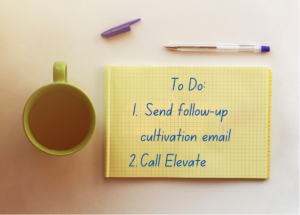
After you are awarded a grant, many funders require a report detailing the work that was completed during the grant period and the impact their support had on your mission-driven efforts. Reporting is a key aspect of funder stewardship! (For more on this, check out our blog post on Grant Report Basics!)
Not all grantmakers ask for reports, but this doesn’t mean you should leave them high and dry! Even if a report isn’t technically required, funders appreciate hearing how their money was used and how their support helped to further your mission. This type of stewardship can help reignite a relationship with a funder and set you up for potential funding in the future—which is especially useful in instances where you are stewarding a first time donor.
For more on cultivating relationships with your funding partners, check out our other blogs on the topic, including Five Ways to be Pleasantly Persistent with your Funder Cultivation and 5 Tips for Converting a Funder “No” into a Future “Yes”.
Earlier in the year, I interviewed Brian Rosenbaum about how his professional training as a social worker and his personal DEI journey have enhanced his ability to fundraise for nonprofits and engage with major donors. During our Q&A, he emphasized the importance of ethical storytelling, which he defined as:
(1) Truthfully representing stories and situations in a way that educates the audience about the systemic and structural issues that challenge people; and
(2) Seeing the client as the teacher and the expert on their own experiences, with both strengths and struggles.
As a fundraising firm, Elevate recognizes the responsibility we have to help our nonprofit partners be better at raising money and supporting their communities while using language that honors the dignity and autonomy of the people and communities they serve.
The Origins of the Ethical Storytelling Movement – Ensuring Stories Do No Harm
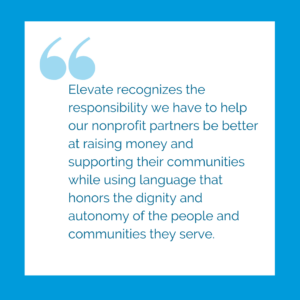 Stories—whether shared verbally, in writing, or through images—have the power to move people to take action. But with this potential to persuade, there is also a high risk of incorporating bias into narratives. Storytellers have the power – whether intentional or not – to inflict harm on the people who are the subjects of their stories.
Stories—whether shared verbally, in writing, or through images—have the power to move people to take action. But with this potential to persuade, there is also a high risk of incorporating bias into narratives. Storytellers have the power – whether intentional or not – to inflict harm on the people who are the subjects of their stories.
When this happens in fundraising, stories can become “transactional”—trading on constituent “suffering” for contributions. If you’ve ever written a grant or a donor appeal letter, you may have been tempted to “tug on the heartstrings” of your reader; in doing so, there is a real risk of telling a story that robs your subject of their dignity.
But there is a different way to originate and tell stories! What if—instead of emotional descriptions of poverty, suffering, or need—your funding requests included stories that celebrated the strengths of a community? What if stories could elevate rather than objectify, and thereby hew closer to the ostensible values and missions of a social-impact organization? It is out of this strength-based rather than deficit-based approach that Rachel Goble, the former CEO The Freedom Story, along with her friends and contacts, brought forward the ethical storytelling movement, along with a dedicated website, EthicalStorytelling.com.
Ethical Storytelling Resources
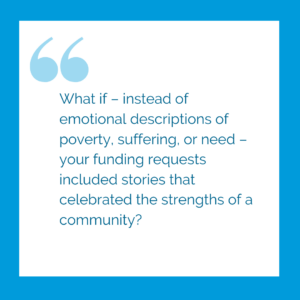 On the EthicalStorytelling.com site, you can find a set of six underlying values, an ethical storytelling pledge, and a collection of resources to guide the storytelling practices of your organization.
On the EthicalStorytelling.com site, you can find a set of six underlying values, an ethical storytelling pledge, and a collection of resources to guide the storytelling practices of your organization.
The pledge urges storytellers to focus on “the HOW, not only the WHAT” of the stories that we encounter—meaning that the process of collecting stories is equally as important as the ultimate content of the stories that are shared. Among others, the pledge includes the commitments to:
- Always put people first.
- Uphold the dignity of constituents through empowering imagery and messages that motivate engagement and inspire hope.
- Truthfully represent a situation or story to educate audiences of the realities, complexities, and nuances of the issues for which you advocate.
- Avoid the use of images, footage, or words that sensationalize or stereotype a person or a situation.
- Ask for feedback from constituents, and incorporate this feedback into the final story.
- Not tell the story, despite the resources invested, when the story cannot be told with the integrity of this pledge.
- Commit to uphold integrity in storytelling and messaging.
The site’s downloadable resources include a child protection policy, a media consent form, and guidance on the use of a victim’s images—valuable tools for any nonprofit organization that wishes to share the stories of the people they serve.
The ethical storytelling approach is aligned with best practices in grant writing and storytelling that employ people-first and strengths-based language. People-first language is language that literally puts the person first. For example, using “a person with diabetes” rather than “diabetic person” when referring to an individual. This framework originated with the disability rights movement and the People with AIDS movement. It has since been reflected in the Americans with Disabilities Act (ADA) and the Individuals with Disabilities Education Act (IDEA).
Keep an eye on this space for more resources on this topic, including examples of Elevate partners that are skillfully applying the principles of ethical storytelling in their work. And for more resources on storytelling, check out Elevate’s previous articles on Using Empowering Language and Inclusive Writing strategies in grants.
Here at Elevate, we have a lot to be proud of, and we aim to celebrate wins large and small. Our hardworking team – 80+ talented grant strategists, writers, and data specialists – work side by side with approximately 100 nonprofits nationwide to secure the resources needed to make a difference across a wide spectrum of issues. We’re proud of each win – from the $10,000 grant from a new partner to the seven-figure award that catapults an organization to the next level of impact. But sometimes, the numbers are so staggering we have to take a minute to pause, reflect, and celebrate!
To that end, we are incredibly proud to share the news with you that:
 Let’s pause for a minute and let this all sink in. If you, like me, lose count past a few zeros, here are a few ways to conceptualize just what a large sum one BILLION is…
Let’s pause for a minute and let this all sink in. If you, like me, lose count past a few zeros, here are a few ways to conceptualize just what a large sum one BILLION is…
- One billion stars equals 1/100 of the Milky Way
- One billion people is one eighth of the world’s population
- One billion seconds is almost 32 years
- One billion steps would result in 15 trips around the equator
Obviously a lot has gone into achieving this milestone over the last 10+ years. Our 2023 Elevate by the Numbers post will give you some idea of the impressive metrics it takes just to win over $100 million annually (which we have succeeded in doing for the last three years). We’re also proud that this cumulative figure includes $11 million in funding our clients won as part of Mackenzie Scott’s highly competitive 2023 Yield Giving Open Call.
Executive Director Sonja Allen offers powerful testimony of how working with Elevate has benefited one such client, Yield Giving winner Friends of Guest House, a Northern Virginia nonprofit that provides housing and reentry services for women who have experienced incarceration: “Elevate’s service model ensures we can raise the funds we need to make a difference in the lives of the women we serve. We are fortunate to have such a strong partner in our mission.”
I’m certain that I speak for all of our staff when I say that it is immensely rewarding to know that this money is going to support the delivery of vital direct services as well as systems change and advocacy efforts in communities across the nation.
Interested in learning more about the clients we serve? Check out this 2023 Meaningful Wins blog. You can also learn more about working with Elevate and our services here.
Over the course of 20+ years, LinkedIn has become a compulsory tool that helps its 1 billion members build their professional networks and access new career opportunities. But did you also know that LinkedIn can play a vital role in helping nonprofits better meet their fundraising goals—specifically by helping them to learn more about what is important to grantmakers as well as how funders are evolving their priorities?
If not, let us fill you in! To tell us more about how LinkedIn can complement more traditional research tools like Candid’s Foundation Directory Online, we spoke with one of Elevate’s Senior Directors of Institutional Fundraising, Noura Hemady. We like to call Noura our LinkedIn Sleuth precisely because she has engineered a unique approach to supplementing more traditional means of funder research with what she is able to glean from her extensive LinkedIn network. She makes it a habit to peruse Linkedin regularly “like some people read the Washington Post or the New York Times” (coffee included). And because a LinkedIn feed is an aggregate, it is like one stop-shopping, so as little as 10 minutes a day can reveal a lot of news.
To help you get started, Noura generously shared the following five introductory tips for nonprofits seeking to unlock opportunities via LinkedIn.
Tip #1: Follow the funder’s people
It’s great to follow LinkedIn company pages, but it’s better to think beyond them. Specifically, take that extra step on LinkedIn and find out who is associated with the funder, and follow these individuals as well. This includes foundation leaders and staff, as well as their media accounts and consultants—don’t be shy! In this way, you will create a strong network to mine for additional information that you may not be able to access in other ways (per Noura’s other tips).
Tip #2: Assess what is getting posted, reposted, and liked
 Once you have built out your connections, lean into what those connections are posting. This includes likes and reposts by program officers and foundation leadership. From there, you can begin to get a clearer picture of foundation alignment—who do they consider to be a part of their affinity group of foundations with shared interests, and what thought leaders, trends, or emerging issues do they deem relevant when it comes to their funding priorities? You may also find potentially aligned funders that you didn’t previously know about — and use traditional research tools to uncover more.
Once you have built out your connections, lean into what those connections are posting. This includes likes and reposts by program officers and foundation leadership. From there, you can begin to get a clearer picture of foundation alignment—who do they consider to be a part of their affinity group of foundations with shared interests, and what thought leaders, trends, or emerging issues do they deem relevant when it comes to their funding priorities? You may also find potentially aligned funders that you didn’t previously know about — and use traditional research tools to uncover more.
For example, one of Noura’s nonprofit clients was looking for a way to revive their relationship with a former funder when she noticed that the funder posted a feature story about her client on LinkedIn. Noura advised the client to view this as a timely opportunity to re-engage with the funder by sending a thank you and an update on the organization’s work.
Tip #3: Read beyond official communications
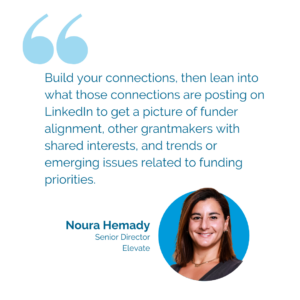 Funder websites are filtered through communications strategies and jargon. As a result, sometimes the highly polished statements of funding priorities and goals found on these official sites are a bit vague and hard to discern. To access a less filtered version of the funder’s agenda and objectives, you can see how program officers are talking about their work at the foundation in their own words via their LinkedIn posts and profiles. Taken alongside reposts and likes, this may help you read between the lines and make a better case for alignment (or alternatively, comprehend if you are not aligned).
Funder websites are filtered through communications strategies and jargon. As a result, sometimes the highly polished statements of funding priorities and goals found on these official sites are a bit vague and hard to discern. To access a less filtered version of the funder’s agenda and objectives, you can see how program officers are talking about their work at the foundation in their own words via their LinkedIn posts and profiles. Taken alongside reposts and likes, this may help you read between the lines and make a better case for alignment (or alternatively, comprehend if you are not aligned).
Tip #4: Take notice of funder meetings and webinars
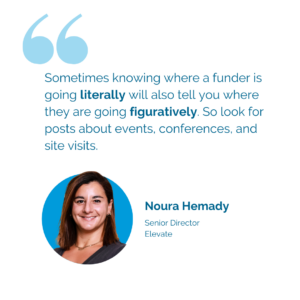 Sometimes knowing where a funder is going literally will also tell you where they are going figuratively. So look for posts about events, conferences, and site visits. These may also inform you about who their grantees are and which organizations they consider to be peers, partners, or otherwise aligned.
Sometimes knowing where a funder is going literally will also tell you where they are going figuratively. So look for posts about events, conferences, and site visits. These may also inform you about who their grantees are and which organizations they consider to be peers, partners, or otherwise aligned.
You also might learn about helpful webinars or virtual events that funders are hosting or attending. For instance, after Noura discovered via LinkedIn that a funder was planning to host a webinar on how to tap into donor-advised funds, her client was able to attend and learn some helpful cultivation tips.
Tip #5: Pay attention to jobs and requests for proposal postings
This is your chance to look into the crystal ball! Before a new portfolio or grantmaking strategy appears on a funder’s website, you might just see hiring posts for new advisors or program officers on LinkedIn first. Similarly, you might get an early glimpse of an RFP or other funding announcements.
For example, Noura noted that a high-profile family foundation posted on LinkedIn about a new program officer position focused on the U.S. South. This position had not yet been posted on the funder’s website. Accordingly, she provided her client with a preview of this new geographic focus.
In another case, a LinkedIn contact Noura was following reposted information about an RFP for expansion into Los Angeles by a new-to-her San Francisco-based funder. She used this information to give her four Los Angeles-based clients a heads up, as each of them had eligible projects. One of these organizations subsequently secured $25,000 in new funding.
So what are you waiting for? Get to sleuthing! It may take some time to build out your Linkedin network in this way, but by following these simple tips, you may reap the dividends!
Also, we’d love to hear from you! Tell us a) if you have any Linkedin fundraising practices that have worked well for you or b) about the results of putting into practice the tips we have suggested here.
Relatedly, please be sure to check out our advice on why you should cultivate relationships with funders. And keep an eye on this space for more tips from Elevate’s fundraising experts!






 At Elevate, leveraging a mix of paid and free prospect research tools ensures high-quality outcomes for clients. Here’s a breakdown of some key tools and how they can elevate your grant-seeking efforts:
At Elevate, leveraging a mix of paid and free prospect research tools ensures high-quality outcomes for clients. Here’s a breakdown of some key tools and how they can elevate your grant-seeking efforts: 3. Inside Philanthropy
3. Inside Philanthropy For example, one Elevate client had gaps in their grant calendar where they should have had grant report deadlines. We discovered this was due to missing and poorly tracked grant agreements – where the information about reporting requirements could be found! This information gap led to several missed report deadlines, putting our client’s funder relationships at risk and delaying new funding (because reporting was required before grants could be renewed.
For example, one Elevate client had gaps in their grant calendar where they should have had grant report deadlines. We discovered this was due to missing and poorly tracked grant agreements – where the information about reporting requirements could be found! This information gap led to several missed report deadlines, putting our client’s funder relationships at risk and delaying new funding (because reporting was required before grants could be renewed. Staff turnover can lead to the loss of critical grant program data. Without a structured system, new team members may struggle to pick up where others left off. Establishing clear documentation, standards, and processes mitigates this risk and allows for smoother transitions between teams.
Staff turnover can lead to the loss of critical grant program data. Without a structured system, new team members may struggle to pick up where others left off. Establishing clear documentation, standards, and processes mitigates this risk and allows for smoother transitions between teams. Set Up Automated Reminders
Set Up Automated Reminders First, there is far more public funding than private funding.
First, there is far more public funding than private funding.  First, talk with your funding partners. Foundations and corporations rely on their grantees to tell them about community needs – it’s why nearly every grant proposal requires you to
First, talk with your funding partners. Foundations and corporations rely on their grantees to tell them about community needs – it’s why nearly every grant proposal requires you to  Keep in mind that the
Keep in mind that the  The efforts to dismantle DEI in philanthropic and nonprofit sectors predates the recent Executive Orders. Our colleague, Johnisha Levi, published
The efforts to dismantle DEI in philanthropic and nonprofit sectors predates the recent Executive Orders. Our colleague, Johnisha Levi, published  Considering a future where you have fewer resources and are thus less able to do this important work can be overwhelming.
Considering a future where you have fewer resources and are thus less able to do this important work can be overwhelming.  Through the new GAP Suite, we’re excited to offer a menu of project-based engagements that are cost efficient, maintain a laser focus on a specific component of an effective grants program, and are modular in order to build on each other in the way that makes the most sense for each organization. Each project within the GAP Suite is a four- or six-week collaboration designed to address a specific strategic fundraising need or question. While we have a standard sequence that many organizations will fit into, we can build out a series of engagements that best fits your needs and resources on a timeline that works for you.
Through the new GAP Suite, we’re excited to offer a menu of project-based engagements that are cost efficient, maintain a laser focus on a specific component of an effective grants program, and are modular in order to build on each other in the way that makes the most sense for each organization. Each project within the GAP Suite is a four- or six-week collaboration designed to address a specific strategic fundraising need or question. While we have a standard sequence that many organizations will fit into, we can build out a series of engagements that best fits your needs and resources on a timeline that works for you.  The headline this year is of course the grant dollars we secured to support our nonprofit partners. This summer, we hit a major milestone: raising
The headline this year is of course the grant dollars we secured to support our nonprofit partners. This summer, we hit a major milestone: raising  In total, Elevate partnered with 143 nonprofit organizations in 2024, including 110 nonprofits that engaged us for our signature
In total, Elevate partnered with 143 nonprofit organizations in 2024, including 110 nonprofits that engaged us for our signature  More specifically, nonprofits must use stories to create emotional connections while also highlighting the root causes of the disparities their clients face. It’s especially important when telling stories of communities that face oppression with funders, decision-makers, and other stakeholders who might not have had the same lived experience as the nonprofit’s clients. If done well, storytelling will counter stereotypes and biases that exist in society and avoid exploiting the clients’ experiences. It will also avoid relying on harmful narratives that inadvertently prevent progress within the communities the nonprofit exists to serve. If nonprofits are to fulfill their job to improve society, they must center equity in everything they do, including the language and stories they use.
More specifically, nonprofits must use stories to create emotional connections while also highlighting the root causes of the disparities their clients face. It’s especially important when telling stories of communities that face oppression with funders, decision-makers, and other stakeholders who might not have had the same lived experience as the nonprofit’s clients. If done well, storytelling will counter stereotypes and biases that exist in society and avoid exploiting the clients’ experiences. It will also avoid relying on harmful narratives that inadvertently prevent progress within the communities the nonprofit exists to serve. If nonprofits are to fulfill their job to improve society, they must center equity in everything they do, including the language and stories they use. When setting out to learn from individuals’ lived experiences, nonprofit professionals must approach this in a way that recognizes the impact of gathering stories from those who have experienced systemic barriers to opportunities and trauma. Focusing on clients’ potential instead of the hardship they have endured can be empowering and provides an opportunity for them to help others who are experiencing similar challenges. By sharing their full humanity, they can change people’s perspectives for the better. Nonprofits that successfully leverage ethical or trauma-informed storytelling can communicate their purpose by sharing impactful stories from their clients’ perspectives while helping new audiences better understand the issues they work on.
When setting out to learn from individuals’ lived experiences, nonprofit professionals must approach this in a way that recognizes the impact of gathering stories from those who have experienced systemic barriers to opportunities and trauma. Focusing on clients’ potential instead of the hardship they have endured can be empowering and provides an opportunity for them to help others who are experiencing similar challenges. By sharing their full humanity, they can change people’s perspectives for the better. Nonprofits that successfully leverage ethical or trauma-informed storytelling can communicate their purpose by sharing impactful stories from their clients’ perspectives while helping new audiences better understand the issues they work on. Grant writing can be a time-consuming activity, so it’s tempting to skip the step of reaching out to a prospective funder before clicking “submit”. While you can often submit a “cold” proposal and still see success, there are a myriad of benefits for engaging in cultivation.
Grant writing can be a time-consuming activity, so it’s tempting to skip the step of reaching out to a prospective funder before clicking “submit”. While you can often submit a “cold” proposal and still see success, there are a myriad of benefits for engaging in cultivation. 
 Stories—whether shared verbally, in writing, or through images—have the power to move people to take action. But with this potential to persuade, there is also a high risk of incorporating bias into narratives. Storytellers have the power – whether intentional or not – to inflict harm on the people who are the subjects of their stories.
Stories—whether shared verbally, in writing, or through images—have the power to move people to take action. But with this potential to persuade, there is also a high risk of incorporating bias into narratives. Storytellers have the power – whether intentional or not – to inflict harm on the people who are the subjects of their stories.  On the EthicalStorytelling.com site, you can find a set of six underlying values, an
On the EthicalStorytelling.com site, you can find a set of six underlying values, an  Let’s pause for a minute and let this all sink in. If you, like me, lose count past a few zeros, here are a few ways to conceptualize just what a large sum one BILLION is…
Let’s pause for a minute and let this all sink in. If you, like me, lose count past a few zeros, here are a few ways to conceptualize just what a large sum one BILLION is… Once you have built out your connections, lean into what those connections are posting. This includes likes and reposts by program officers and foundation leadership. From there, you can begin to get a clearer picture of foundation alignment—who do they consider to be a
Once you have built out your connections, lean into what those connections are posting. This includes likes and reposts by program officers and foundation leadership. From there, you can begin to get a clearer picture of foundation alignment—who do they consider to be a  Funder websites are filtered through communications strategies and jargon. As a result, sometimes the highly polished statements of funding priorities and goals found on these official sites are a bit vague and hard to discern. To access a less filtered version of the funder’s agenda and objectives, you can see how program officers are talking about their work at the foundation in their own words via their LinkedIn posts and profiles. Taken alongside reposts and likes, this may help you read between the lines and make a better case for alignment (or alternatively, comprehend if you are not aligned).
Funder websites are filtered through communications strategies and jargon. As a result, sometimes the highly polished statements of funding priorities and goals found on these official sites are a bit vague and hard to discern. To access a less filtered version of the funder’s agenda and objectives, you can see how program officers are talking about their work at the foundation in their own words via their LinkedIn posts and profiles. Taken alongside reposts and likes, this may help you read between the lines and make a better case for alignment (or alternatively, comprehend if you are not aligned). Sometimes knowing where a funder is going
Sometimes knowing where a funder is going 